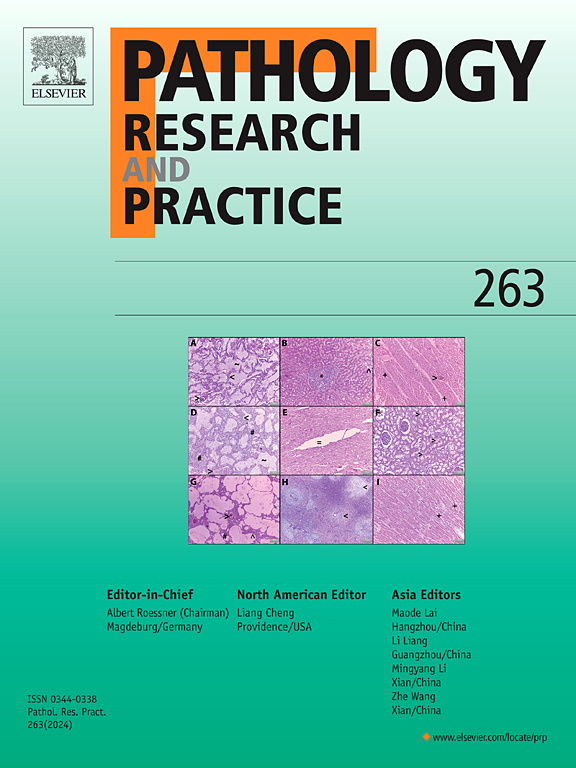Clinicopathological features of dermal clear cell sarcoma: A series of 13 cases
IF 3.2
4区 医学
Q2 PATHOLOGY
引用次数: 0
Abstract
Background
Dermal clear cell sarcoma (DCCS) is a rare malignant mesenchymal neoplasm. Owing to the overlaps in its morphological and immunophenotypic profiles with a broad spectrum of tumors exhibiting melanocytic differentiation, it is frequently misdiagnosed as other tumor entities in clinical practice. By systematically analyzing the clinicopathological characteristics, immunophenotypic features, and molecular biological properties of DCCS, this study intends to further enhance pathologists' understanding of this disease and provide a valuable reference for its accurate diagnosis.
Methods
A retrospective analysis was conducted on the clinicopathological data of 13 patients diagnosed with DCCS at the First Affiliated Hospital of Air Force Medical University from January 2012 to December 2024. The histopathological features, immunophenotypic profiles, and molecular characteristics of tumors were systematically assessed. Furthermore, detailed prognostic information of the patients was collected through telephone follow-up.
Results
Among the 13 patients diagnosed with DCCS, there were 5 males and 8 females, with a mean age of 32.7 years. Tumors were predominantly located in the distal extremities. 3 patients had a prior history of trauma or surgery, while bone destruction was identified in 5 cases via imaging examinations. Grossly, the tumors appeared as grayish-white or white nodules with a hard texture. Microscopically, 2 tumors involved both the dermis and epidermis, while the other 11 were confined to the dermis. Tumor cells were arranged in nests, fascicles, sheets, mainly spindle-shaped or epithelioid in morphology. "Wreath-like" multinucleated giant cells were observed in 3 cases, and collagenous fibrous septa were present in the stroma of all tumors. All tumors showed diffuse expression of S100 or SOX10, and HMB-45, Melan-A, and MITF were positive to varying degrees. EWSR1 (22q12) gene breakage was detected by fluorescence in situ hybridization (FISH) in all 10 tested cases. Among the cases examined by next-generation sequencing (NGS), 2 had the EWSR1::ATF1 fusion gene and 1 had the EWSR1::CREB1 fusion gene.
Conclusion
DCCS is relatively rare in clinical practice. Its pathogenesis may be associated with a prior history of trauma or surgery; however, this potential association requires further validation through the accumulation of additional cases. Given the overlaps in morphological and immunohistochemical features between DCCS and other tumors exhibiting melanocytic differentiation, molecular testing (including the detection of EWSR1 gene rearrangement or specific fusion genes detection) holds significant value for the accurate diagnosis of primary DCCS.
皮肤透明细胞肉瘤13例临床病理特征分析
背景:真皮透明细胞肉瘤是一种罕见的恶性间质肿瘤。由于其形态和免疫表型与广泛的黑色素细胞分化肿瘤重叠,在临床实践中经常被误诊为其他肿瘤实体。本研究旨在通过系统分析DCCS的临床病理特征、免疫表型特征及分子生物学特性,进一步提高病理学家对该疾病的认识,为其准确诊断提供有价值的参考。方法回顾性分析2012年1月至2024年12月在空军医科大学第一附属医院诊断为DCCS的13例患者的临床病理资料。系统评估肿瘤的组织病理学特征、免疫表型和分子特征。此外,通过电话随访收集患者的详细预后信息。结果13例确诊为DCCS的患者中,男性5例,女性8例,平均年龄32.7岁。肿瘤主要位于远端肢体。3例患者既往有外伤或手术史,5例影像学检查发现骨破坏。肉眼可见灰白色或白色结节,质地坚硬。显微镜下,2例肿瘤累及真皮和表皮,11例局限于真皮。肿瘤细胞呈巢状、束状、片状排列,形态上以梭形或上皮样为主。3例可见“花环状”多核巨细胞,所有肿瘤间质均可见胶原纤维间隔。所有肿瘤均弥漫性表达S100或SOX10, HMB-45、Melan-A、MITF均不同程度阳性。荧光原位杂交(FISH)检测10例EWSR1 (22q12)基因断裂。在新一代测序(NGS)检测的病例中,2例具有EWSR1::ATF1融合基因,1例具有EWSR1::CREB1融合基因。结论dccs在临床上较为少见。其发病机制可能与既往创伤或手术史有关;然而,这种潜在的关联需要通过积累更多的病例来进一步验证。考虑到DCCS与其他黑色素细胞分化肿瘤在形态学和免疫组化特征上的重叠,分子检测(包括EWSR1基因重排检测或特异性融合基因检测)对原发DCCS的准确诊断具有重要价值。
本文章由计算机程序翻译,如有差异,请以英文原文为准。
求助全文
约1分钟内获得全文
求助全文
来源期刊
CiteScore
5.00
自引率
3.60%
发文量
405
审稿时长
24 days
期刊介绍:
Pathology, Research and Practice provides accessible coverage of the most recent developments across the entire field of pathology: Reviews focus on recent progress in pathology, while Comments look at interesting current problems and at hypotheses for future developments in pathology. Original Papers present novel findings on all aspects of general, anatomic and molecular pathology. Rapid Communications inform readers on preliminary findings that may be relevant for further studies and need to be communicated quickly. Teaching Cases look at new aspects or special diagnostic problems of diseases and at case reports relevant for the pathologist''s practice.

 求助内容:
求助内容: 应助结果提醒方式:
应助结果提醒方式:


